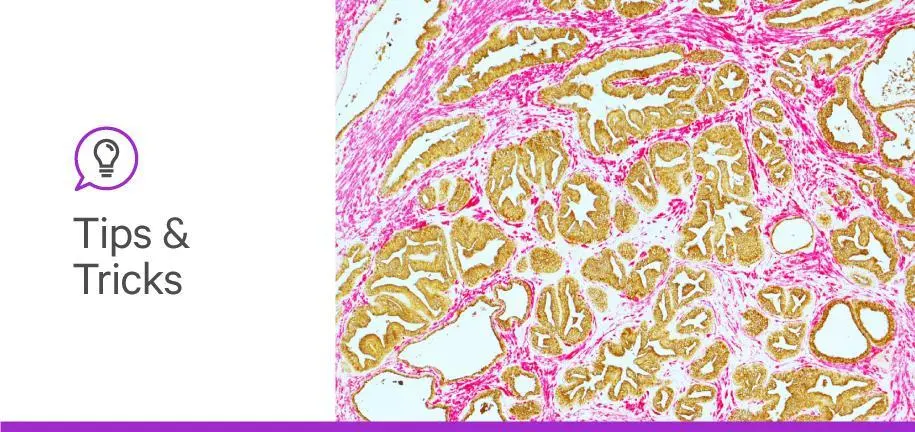
Vector Laboratories is closed for the President’s Day on Monday, February 19th. We will be back in the office on Tuesday, February 20th.
We will respond to emails upon our return. Have a wonderful day.
Menu
Vector Laboratories is closed for the President’s Day on Monday, February 19th. We will be back in the office on Tuesday, February 20th.
We will respond to emails upon our return. Have a wonderful day.

The process of performing immunohistochemistry (IHC) and immunofluorescence (IF) can be very complex. There are many issues that can arise, and the solutions to fix the problems can be confusing. One pain can be the lack of positive staining on your tissue sections. In this blog post, we will offer tips and tricks for overcoming the absence of positive staining in IHC and IF.
This blog post is the second of a three-part series intended to help researchers navigate different parts of the IHC and IF staining processes that might present challenges. The first part of the series covered background staining. Be sure to stay tuned for other insights that could help your workflow achieve better staining results.
When performing IHC and IF, it is important to ensure that every part of your workflow is compatible with the other. You’ll first want to ensure your primary antibody is compatible with not only the species of the tissue you’re staining, but that it is also compatible with the secondary antibody you’re using. Furthermore, while the primary antibody might have worked for you in the past, you’ll want to make sure it has been validated for your application and that you are using the right concentration by performing a titer.
Just as you ensured the compatibility of the primary antibody, you’ll want to do the same with your secondary detection. The secondary antibody should match not only the primary antibody and tissue species, but should be compatible with any blocking solutions you use in the workflow.
Performing IHC and IF is not a one size fits all. Every step of your workflow must be optimized to ensure the appropriate staining results occur. A common mistake researchers make is not ensuring the antigen retrieval is appropriate, or that it has been optimized. Protocols for antigen retrieval can vary, so making sure each aspect of the process from pH, temperature, duration of sample immersion, and instrument compatibility is optimized is important for achieving consistent positive results. Furthermore, if your target antigen is absent or weakly expressed, you may need a more sensitive detection system.
When optimizing your workflow, you’ll also want to ensure you have a negative and positive control set up. Positive controls allow you to examine your assay’s specificity and sensitivity while negative controls allow you to identify and eliminate false positive staining so that you can be certain your results aren’t leading you to an inaccurate conclusion. A good way to start is by choosing a positive control sample that expresses a moderate to high level of your target antigen. For a negative control, simply substitute a non-immune Immunoglobulin G (IgG)—meaning if your primary antibody is a mouse IgG, you would use a non-immune mouse IgG. Make sure you treat the controls the exact same way you treat your experimental samples, from fixation to mounting and imaging.
When it comes to selecting the substrate for your IHC application, there is a variety of substrates that are flexible for your needs. That being said, there are different factors to consider when selecting the appropriate substrate for your experiment, such as the enzyme, sensitivity, color, method of visualization, and stability. In this blog post, we will specifically highlight the importance of matching the substrate with the correct enzyme, but if you’re interested in learning about the other factors, be sure to check out A Simple Guide to Immunohistochemistry Substrate Selection.
IHC detection systems usually include two different enzymes—horseradish peroxidase (HRP) and alkaline phosphate (AP). Substrates are enzyme-specific, so an HRP substrate will not react with an AP-based detection system and an AP substrate will not react with an HRP-based detection system.
This might come as a surprise, but the mounting step can be a crucial part of ensuring proper results. It is important to choose the appropriate mounting media for your experiment, especially for immunofluorescence, as choosing the appropriate mounting media can help prevent photobleaching. To learn more about the ins and outs of mounting media for IHC and IF, be sure to check out The End of the Line: Considerations for Mounting Media Selection.
We hope the above tips were helpful and get you on the road to better staining. We know there are many more problems and solutions that can arise in your workflow, so for more tips and tricks to improve your staining, check out our IHC and IF Resources, and stay tuned for more help on the blog.





Stay in the Loop. Join Our Online Community
Together we breakthroughTM

©Vector Laboratories, Inc. 2024 All Rights Reserved.